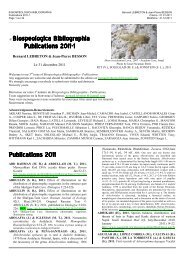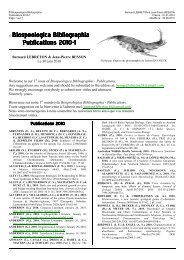Biospeologica Bibliographia Publications 2010-2
Biospeologica Bibliographia Publications 2010-2
Biospeologica Bibliographia Publications 2010-2
Create successful ePaper yourself
Turn your PDF publications into a flip-book with our unique Google optimized e-Paper software.
© <strong>Biospeologica</strong> <strong>Bibliographia</strong><br />
<strong>Publications</strong> <strong>2010</strong>-1<br />
Page 8 sur 116<br />
Bacterial Calcium Carbonate Precipitation in Cave<br />
Environments: A Function of Calcium Homeostasis.<br />
Geomicrobiology Journal 27(5, July):444-445. DOI:<br />
http://dx.doi.org/10.1080/01490450903485136. ABS: To<br />
determine if microbial species play an active role in the development of<br />
calcium carbonate (CaCO 3) deposits (speleothems) in cave environments,<br />
we isolated 51 culturable bacteria from a coralloid speleothem and tested<br />
their ability to dissolve and precipitate CaCO 3. The majority of these<br />
isolates could precipitate CaCO 3 minerals; scanning electron microscopy<br />
and X-ray diffractrometry demonstrated that aragonite, calcite and<br />
vaterite were produced in this process. Due to the inability of dead cells<br />
to precipitate these minerals, this suggested that calcification requires<br />
metabolic activity. Given growth of these species on calcium acetate, but<br />
the toxicity of Ca 2+ ions to bacteria, we created a loss-of-function gene<br />
knock-out in the Ca 2+ ion efflux protein ChaA. The loss of this protein<br />
inhibited growth on media containing calcium, suggesting that the need to<br />
remove Ca 2+ ions from the cell may drive calcification. With no carbonate<br />
in the media used in the calcification studies, we used stable isotope<br />
probing with C13O 2 to determine whether atmospheric CO 2 could be the<br />
source of these ions. The resultant crystals were significantly enriched in<br />
this heavy isotope, suggesting that extracellular CO 2 does indeed<br />
contribute to the mineral structure. The physiological adaptation of<br />
removing toxic Ca 2+ ions by calcification, while useful in numerous<br />
environments, would be particularly beneficial to bacteria in Ca 2+ -rich<br />
cave environments. Such activity may also create the initial crystal<br />
nucleation sites that contribute to the formation of secondary CaCO 3<br />
deposits within caves. KW: Calcite, calcium caves, coralloids,<br />
homeostasis, speleothems.<br />
BARATTI (M.), FILIPPELLI (M.), NARDI (F.) &<br />
MESSANA (G.), <strong>2010</strong>. Molecular phylogenetic<br />
relationships among some stygobitic cirolanid species<br />
(Crustacea, Isopoda). Contributions to Zoology 79(2):57-<br />
67. ABS: Within the Cirolanidae, a widespread family of marine<br />
isopods, about 23 genera are stygobitic and inhabit phreatic and<br />
anchialine ecosystems, with many endemic species. The Mediterranean<br />
area has a high biodiversity of subterranean cirolanids, which are<br />
considered thalassoid limnostygobionts. A molecular analysis was<br />
conducted using mtDNA genes to infer the phylogeny of species<br />
belonging to six of the seven stygobitic genera of Cirolanidae inhabiting<br />
the Mediterranean basin and to two American taxa: Faucheria faucheri,<br />
Marocolana delamarei, Saharolana seurati, Sphaeromides virei virei,<br />
Turcolana sp., 13 taxa of the genus Typhlocirolana and two American<br />
species, Antrolana lira and Speocirolana bolivari. The Typhlocirolana<br />
species are widespread in the western Mediterranean basin, with a<br />
concentration of taxa in the Maghreb region. Turcolana sp. is localised in<br />
the eastern Mediterranean, while F. faucheri and S. v. virei are north<br />
Mediterranean taxa. S. seurati, the taxon least morphologically adapted to<br />
subterranean life, belongs to a monospecific genus present in a Tunisian<br />
spring. The molecular phylogeny showed a high affinity among the<br />
American taxa and the Mediterranean Sphaeromides, clustering in the<br />
Sphaeromides group identified by previous morphological studies.<br />
Typhlocirolana species and M. delamarei constitute their sister clade<br />
within the Sphaeromides group. F. faucheri appears to be a sister clade of<br />
the Sphaeromides group. S. seurati, showing reduced troglobitic<br />
adaptations, assumes disparate and unsolved positions in the phylogenetic<br />
reconstructions. The molecular data suggest that a combination of<br />
vicariance and dispersal events, occurring from 180 to a few million years<br />
ago, combined to bring about the present distribution pattern of<br />
Mediterranean cirolanid isopods. KW: 12S, 16S, Cirolanidae, cytochrome<br />
oxidase I, mitochondrial DNA, stygofauna.<br />
http://dpc.uba.uva.nl/cgi/t/text/textidx?c=ctz;sid=11723560e12646d77667770712bc2003;rgn=main;idno=m<br />
7902a01;view=text<br />
BARATTI (M.), MESSANA (G.), FILIPPELLI (M.) &<br />
SKET (B.), <strong>2010</strong>. New biogeographical and phylogenetic<br />
data about the genus Sphaeromides and its relatives<br />
(Crustacea: Isopoda: Cirolanidae):55-56. In: 20 th<br />
International Conference on Subterranean Biology,<br />
Postojna, Slovenia, 29 August-3 September <strong>2010</strong>, ICSB<br />
<strong>2010</strong> Abstract Book, edited by: Ajda MOŠKRIČ and Peter<br />
TRONTELJ, ISBN 978-961-269-286-5. ABS: Sphaeromides<br />
spp. are among the most remarkable aquatic troglobionts. The putative<br />
genus exhibits a trans dinaric distribution, with a pronounced diversity in<br />
Bernard LEBRETON & Jean-Pierre BESSON<br />
Créé le : 01.01.<strong>2010</strong><br />
Modifié le : 30.06.<strong>2010</strong><br />
the Dinaric karst, but occurring also outside it, in France and Bulgaria.<br />
We succeeded to sample the genus from ca 17 localities throughout its<br />
range (except in Bosanska Krajina). A molecular analysis was conducted<br />
using mtDNA genes (16S rRNA and COXI) at two levels: 1) to infer the<br />
phylogenetic relationships of the Sphaeromides species with the other<br />
subterranean cirolanid taxa, and 2) to investigate the phylogeography of<br />
the S. virei populations in the Dinarides and its relationships with the<br />
other Sphaeromides species (S. raymondi and S. bureschi). The 16S tree,<br />
including available GenBank cirolanid sequences, show that<br />
Sphaeromides, as conceived now, is a polyphyletic assemblage. S.<br />
raymondi from France is a sister taxon to the eastern Sphaeromides spp.<br />
plus some American genera (Cirolanides and Antrolana from USA and<br />
Speocirolana and Sphaerolana from Mexico). The populations of the S.<br />
virei comprise until now the two subspecies S. v. virei and S. v.<br />
mediodalmatina. S. virei occurs only along the eastern Adriatic coast, but<br />
always in pure fresh water, while S. mediodalmatina is limited to the<br />
central inland parts of Dalmacija. In the phylogenetic reconstruction, S.<br />
virei is again a monophylum, probably representing separate genus,<br />
inhabiting the Dinaric and western Balkan (or Stara planina) karst. The<br />
COI and the 16S trees show that S. virei may be regarded as at least two<br />
distinct species, since the supposed subspecies S. virei mediodalmatina is<br />
a very distinct phyletic line and beside that it occurs in one cave<br />
syntopically with S. v. virei. These molecular investigations sustain new<br />
evidences about the genus Sphaeromides, which should be supported by a<br />
complete morphological analysis of the genus. http://www.icsb<strong>2010</strong>.net/<br />
BARBIER (C.), <strong>2010</strong>. Massif de la Sainte-Victoire (Bouchesdu-Rhône).<br />
Spelunca 117(Mars, 1 er trimestre):23-31. BL: Cf<br />
p. 24-25: Aven RCPR (Refuge Chiroptères Petits Rhinolophes), 2004,<br />
Massif de la Sainte-Victoire (Vauvenargues). Comme elle abrite<br />
également quelques chiroptères, nous avons décidé de ne pas publier ses<br />
coordonnées pour donner encore cinquante ans de tranquillité à ces<br />
charmants animaux.<br />
BARCIOVÁ (T.), KOVÁČ (ĽU.) & MIKLISOVÁ (D.),<br />
<strong>2010</strong>. Impact of tourism upon structure and diversity of<br />
Collembola assemblages (Hexapoda) - a case study of the<br />
Gombasecká Cave, Slovak Karst (Slovakia). Slovenský<br />
Kras Acta Carsologica Slovaca 48(2):271-283. ABS: In<br />
1998-2000 and 2006-2007 investigations were carried out in the<br />
Gombasecká Cave (Slovak Karst, Slovakia) to assess potential impact of<br />
tourism upon the communities of terrestrial Arthropoda with special<br />
reference to Collembola. Pitfall trapping with different fixation liquids<br />
and extraction of baits and organic debris (rotten wood) were used as<br />
basic collecting methods. Five sites were selected for detail study in<br />
different distance from the tourist path. In total, 52 Collembola were<br />
registered during the study in the Gombasecká Cave, rather low species<br />
number (27) was detected in its internal parts that is likely linked with<br />
oligotrophic conditions and low impact of tourism. Four species were<br />
troglobiotic, Arrhopalites aggtelekiensis, Deuteraphorura schoenviszkyi,<br />
Deuteraphorura cf. kratochvili and Pseudosinella aggtelekiensis, all<br />
representing Western Carpathian endemics. They populated preferably<br />
the deeper cave parts with exception of P. aggtelekiensis that occurred<br />
also at both entrance sites. Eutroglophiles Arrhopalites pygmaeus,<br />
Arrhopalites caecus and Folsomia candida dominanted in the cave.<br />
Collembolan assemblages of the entrance sites differed from those<br />
situated in greater distances from the cave entrance. Within adjacent<br />
reference localities not open to public, Stará Brzotínska and Nová<br />
Brzotínska caves, 22 and 21 collembolan species were recorded,<br />
respectively. Three obligate cave species were registered in both caves, A.<br />
aggtelekiensis, D. schoenviszkyi and D. cf. kratochvili;. eutroglophiles<br />
Plutomurus carpaticus, Folsomia candida and Arrhopalites pygmaeus<br />
were the most abundant. The study revealed a great level of similarity of<br />
Collembola between tourist and reference caves investigated. However,<br />
Plutomurus carpaticus, abundant and frequent in the Brzotínska Cave<br />
system, was absent in the Gombasecká Cave. In contrary, troglobiotic<br />
Pseudosinella aggtelekiensis, rather frequent in the Gombasecká Cave<br />
was totally absent in the Brzotínska Cave system. In the studied show<br />
cave we observed no clear negative effect of tourism upon Collembola<br />
communities close to the tourist path. KW: Collembola, tourist cave,<br />
Slovak Karst, Gombasecká Cave, troglobiotic species, cave fauna.<br />
BARRANCO (P.), <strong>2010</strong>. Una nueva especie de Petaloptila de<br />
la provincia de Málaga (España) (Orthoptera, Gryllidae).<br />
Boletín de la Asociación española de Entomología<br />
34(1/2):207-217. RES: Se describe una nueva especie de ortóptero en<br />
cuevas de Andalucía (España).<br />
http://liberagnitio.org/webs/AeE/index.php?d=publicaciones&num=47





